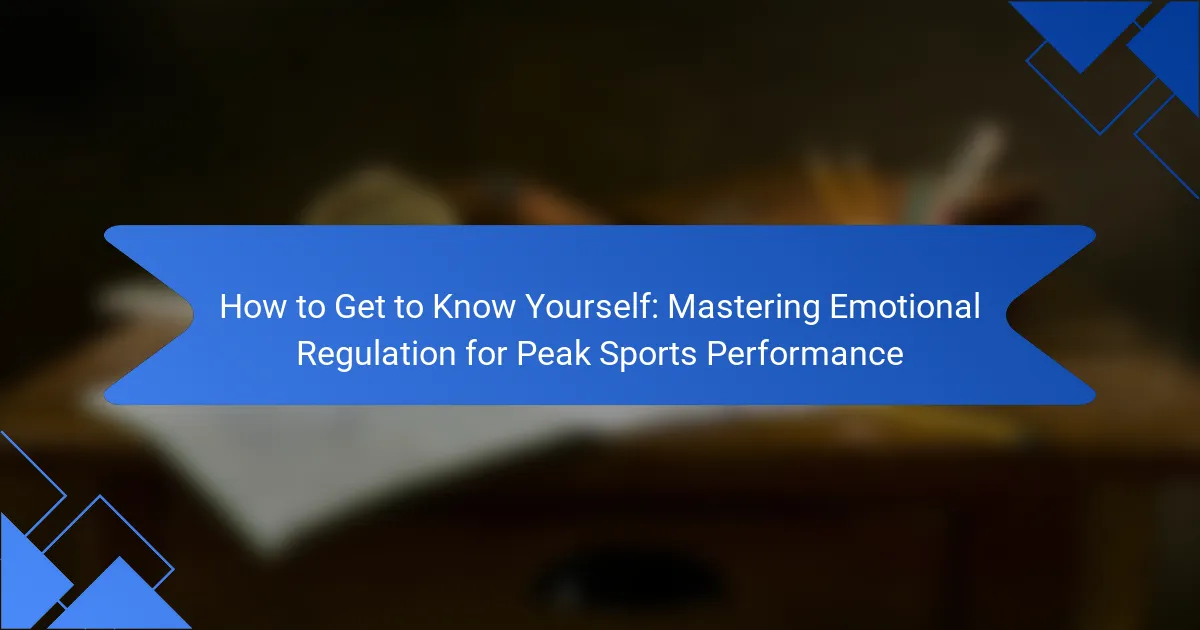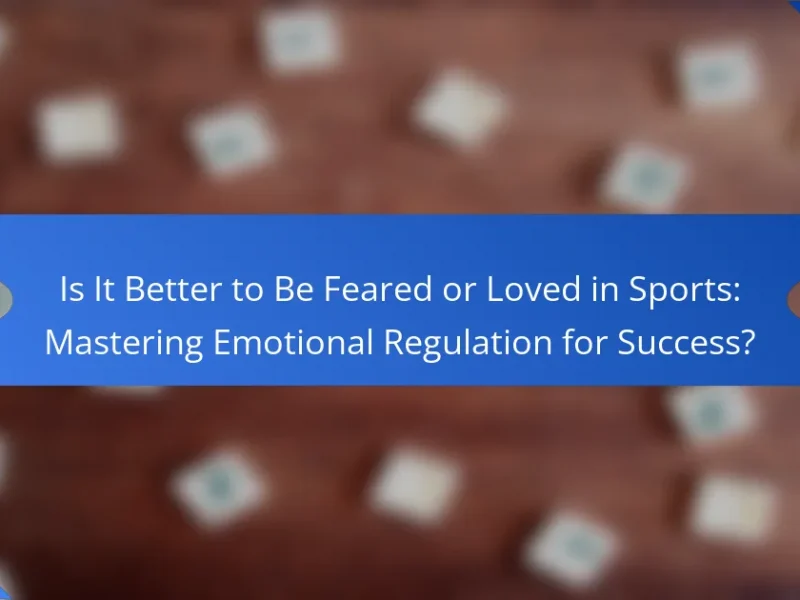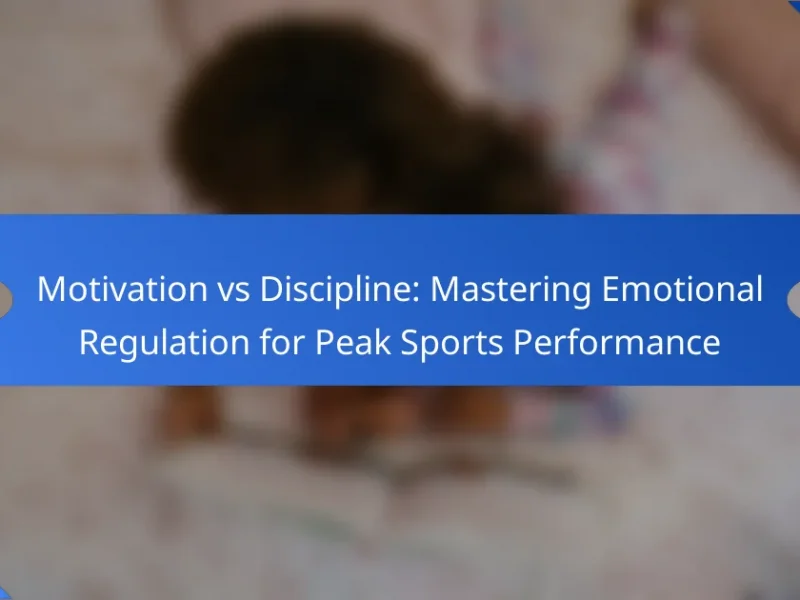Mastering emotional regulation is essential for athletes seeking peak performance. This article explores strategies like self-awareness, mindfulness, and cognitive restructuring. It highlights unique approaches for different sports and addresses common mistakes that hinder emotional control. Implementing these techniques can significantly enhance focus, resilience, and overall performance in competitive environments.
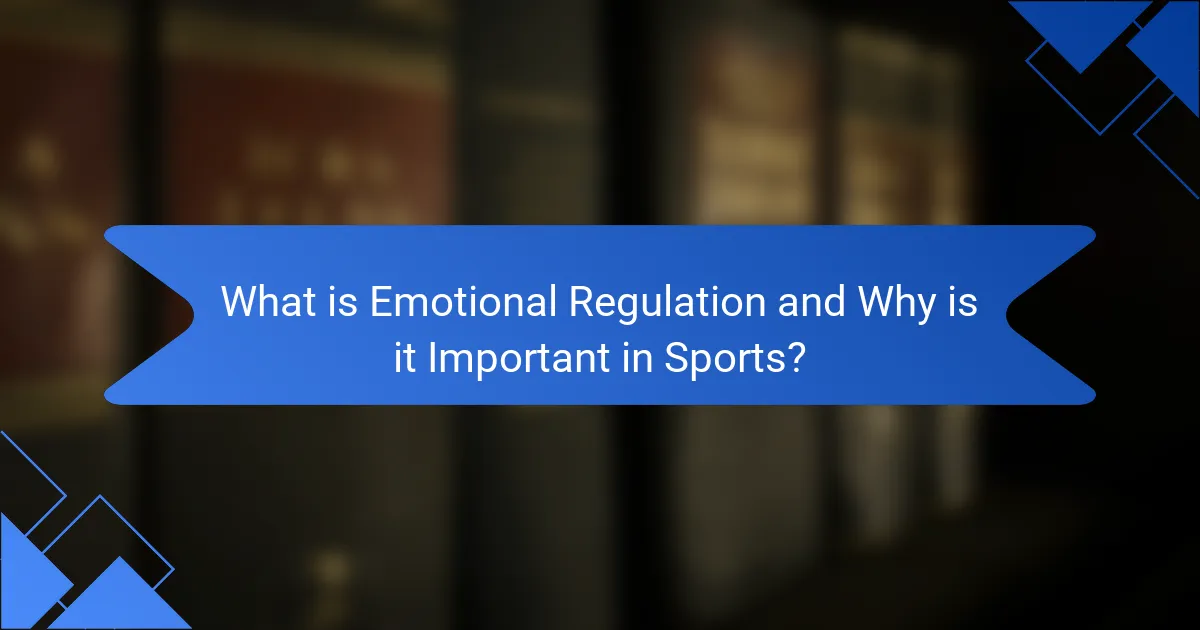
What is Emotional Regulation and Why is it Important in Sports?
Emotional regulation is the ability to manage and respond to emotional experiences effectively, crucial for sports performance. It enhances focus, resilience, and decision-making under pressure. Athletes who master emotional regulation experience improved consistency in performance, as they can maintain composure during high-stakes situations. This skill also fosters better teamwork and communication, leading to a more cohesive environment. Training in emotional regulation can significantly elevate an athlete’s competitive edge.
How Does Emotional Regulation Impact Athletic Performance?
Emotional regulation significantly enhances athletic performance by improving focus and reducing anxiety. Athletes who master emotional regulation can maintain composure under pressure, leading to better decision-making and execution of skills. Studies show that athletes with high emotional intelligence perform better in competitive settings, as they can manage stress and maintain motivation. As a result, developing emotional regulation techniques is essential for peak sports performance.
What Are the Key Components of Emotional Regulation Systems?
Key components of emotional regulation systems include awareness, understanding, and management of emotions. These systems consist of cognitive appraisal, emotional expression, and behavioral responses. Cognitive appraisal helps athletes assess situations, while emotional expression allows them to communicate feelings effectively. Management strategies, such as mindfulness and self-talk, enhance performance by maintaining focus and reducing anxiety.
How Do Emotions Affect Decision-Making in Sports?
Emotions significantly influence decision-making in sports by affecting focus, risk assessment, and performance. Athletes who master emotional regulation can enhance their decision-making abilities. Emotional awareness allows for better control over reactions, leading to improved outcomes. Studies show that athletes with high emotional intelligence make more strategic choices under pressure, resulting in peak performance.
What Role Does Stress Play in Athletic Performance?
Stress significantly impacts athletic performance by influencing emotional regulation. High stress can impair focus and decision-making, while effective stress management enhances resilience and consistency. Athletes who master emotional regulation can maintain optimal performance under pressure. Research indicates that emotional control correlates with improved outcomes in competitive environments, highlighting the importance of mental training alongside physical preparation.
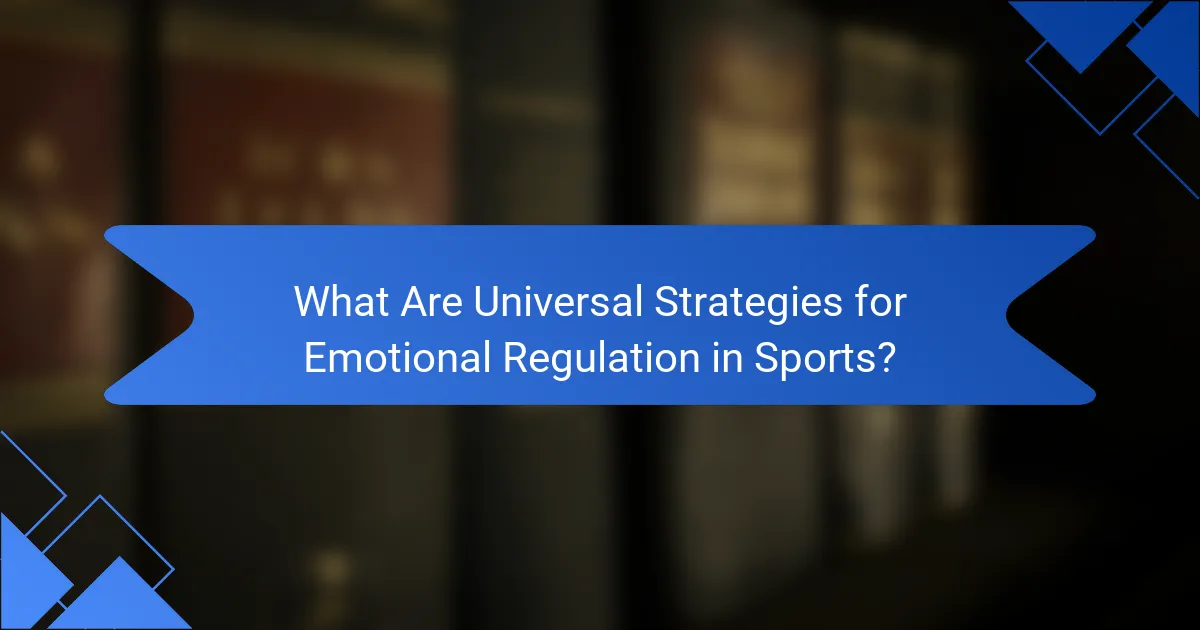
What Are Universal Strategies for Emotional Regulation in Sports?
To master emotional regulation in sports, athletes can implement strategies like self-awareness, mindfulness, and cognitive restructuring. These techniques enhance performance under pressure and foster resilience.
Self-awareness involves recognizing emotions and triggers, allowing athletes to manage responses effectively. Mindfulness practices, such as meditation, help maintain focus and reduce anxiety. Cognitive restructuring encourages athletes to challenge negative thoughts and replace them with constructive ones.
Incorporating these strategies can lead to improved emotional control, resulting in better decision-making and performance during competitions. Emotional regulation not only enhances individual performance but also contributes to overall team dynamics.
How Can Athletes Recognize Their Emotional Triggers?
Athletes can recognize their emotional triggers by engaging in self-reflection and monitoring their emotional responses during training and competition. Identifying patterns in emotions related to specific situations enhances emotional regulation. Keeping a journal can help track feelings and reactions, leading to greater self-awareness. Additionally, seeking feedback from coaches and peers can provide insights into emotional responses, aiding in the mastery of emotional regulation for peak performance.
What Techniques Can Help Manage Emotions During Competition?
To manage emotions during competition, athletes can use techniques such as mindfulness, visualization, and deep breathing. Mindfulness helps maintain focus and reduces anxiety by centering attention on the present moment. Visualization allows athletes to mentally rehearse their performance, enhancing confidence and emotional preparedness. Deep breathing techniques regulate physiological responses, promoting calmness and clarity under pressure. These strategies foster emotional regulation, ultimately improving sports performance.
How to Implement Breathing Techniques for Calmness?
To implement breathing techniques for calmness, start by practicing deep, diaphragmatic breathing. This method enhances emotional regulation, crucial for peak sports performance. Focus on inhaling slowly through your nose for a count of four, holding for four, and exhaling through your mouth for a count of six. Regular practice can reduce anxiety and improve focus, leading to better performance outcomes.
What Is the Role of Visualization in Emotional Regulation?
Visualization plays a crucial role in emotional regulation by enhancing self-awareness and focus. It allows athletes to mentally rehearse scenarios, reducing anxiety and improving performance. By visualizing successful outcomes, athletes can build confidence, manage stress, and maintain composure under pressure. This technique fosters a positive mindset, which is essential for peak sports performance.
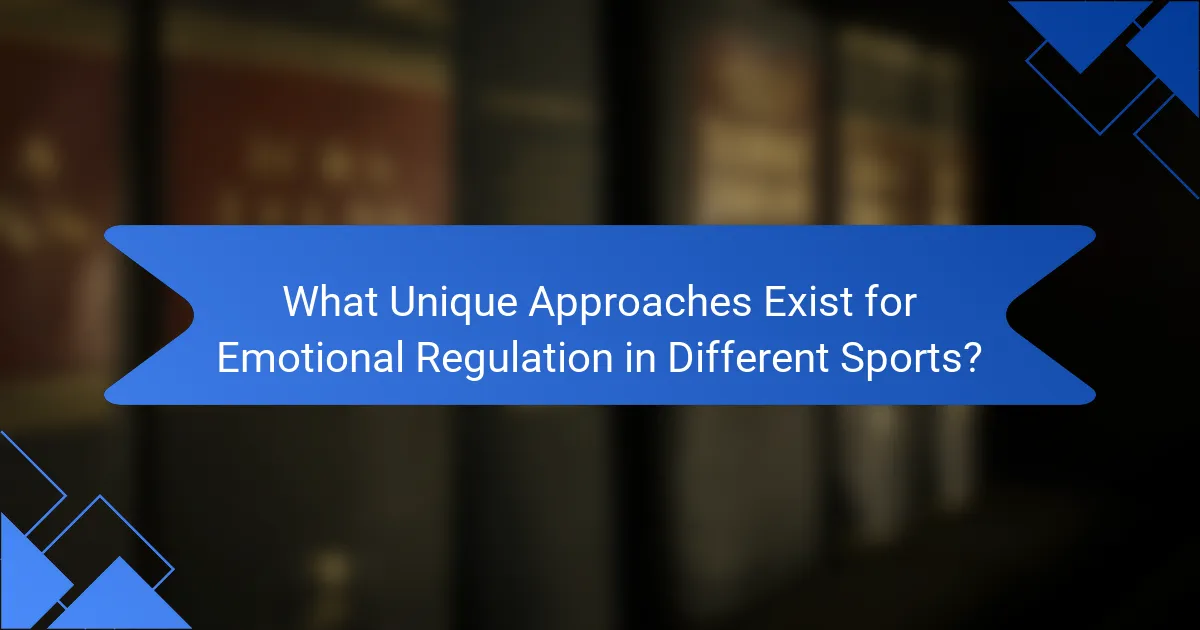
What Unique Approaches Exist for Emotional Regulation in Different Sports?
Unique approaches for emotional regulation in different sports include mindfulness techniques, visualization strategies, and cognitive-behavioral methods. Athletes in individual sports often use mindfulness to enhance focus and reduce anxiety, while team sports may emphasize communication and collective emotional management. For instance, a study found that mindfulness training improved performance in tennis players by reducing stress levels. Visualization techniques, such as mental rehearsal, are frequently employed in sports like gymnastics and diving to enhance confidence and prepare for competition. Cognitive-behavioral methods help athletes identify and modify negative thought patterns, improving their emotional resilience across various sports.
How Do Team Sports Differ from Individual Sports in Emotional Management?
Team sports often require more collective emotional management than individual sports. In team settings, athletes must navigate group dynamics, fostering collaboration and communication. This shared experience enhances emotional resilience through mutual support. Conversely, individual sports focus on self-regulation, where athletes develop personal coping strategies to manage stress and performance pressure. Both approaches cultivate emotional intelligence but differ in social interaction’s role. Team sports emphasize relational skills, while individual sports prioritize self-awareness and independence.
What Unique Emotional Regulation Techniques Do Elite Athletes Use?
Elite athletes use unique emotional regulation techniques to enhance performance, such as mindfulness, visualization, and breathing exercises. Mindfulness helps athletes remain present, reducing anxiety. Visualization allows them to mentally rehearse success, boosting confidence. Breathing exercises promote calmness and focus, especially under pressure. These techniques are essential for mastering emotional regulation and achieving peak performance.
What Practices Are Common Among Olympic Athletes?
Olympic athletes commonly practice emotional regulation techniques to enhance performance. These practices include mindfulness, visualization, and self-talk strategies. Mindfulness helps athletes stay present and focused, reducing anxiety. Visualization allows them to mentally rehearse events, boosting confidence. Positive self-talk reinforces belief in their abilities, fostering resilience.
How Do Coaches Influence Emotional Regulation in Their Teams?
Coaches significantly influence emotional regulation in their teams by modeling behaviors and creating supportive environments. They can establish trust, encourage open communication, and provide constructive feedback, which enhances emotional awareness. Coaches also teach coping strategies, helping athletes manage stress and anxiety during competition. By fostering a culture of resilience, coaches empower athletes to navigate emotional challenges effectively. This unique attribute of coaching leads to improved team cohesion and performance.
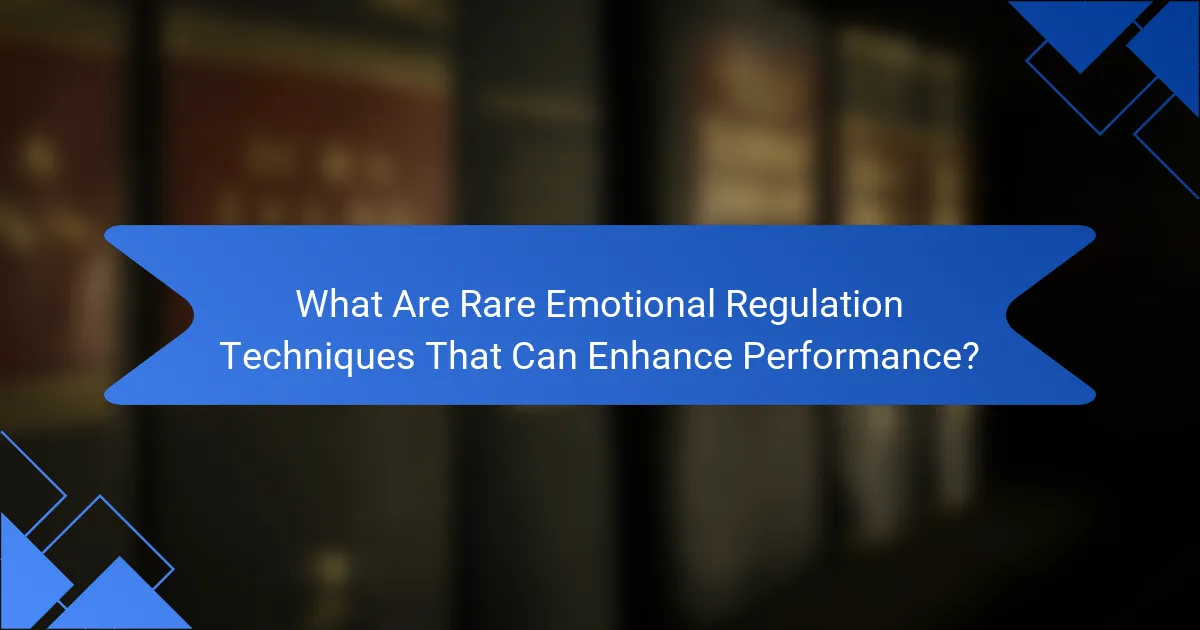
What Are Rare Emotional Regulation Techniques That Can Enhance Performance?
Rare emotional regulation techniques can significantly enhance sports performance. Techniques such as mindfulness meditation, emotional journaling, and visualization exercises help athletes manage stress and improve focus. Mindfulness meditation promotes awareness and emotional control, enabling athletes to stay present during competition. Emotional journaling allows for reflection on feelings, fostering self-awareness and resilience. Visualization exercises enhance mental imagery, preparing athletes mentally for peak performance. Implementing these techniques can lead to improved emotional regulation, ultimately enhancing overall performance in sports.
What Innovative Methods Are Emerging in Sports Psychology?
Innovative methods in sports psychology focus on emotional regulation techniques to enhance performance. Techniques like mindfulness training, cognitive-behavioral strategies, and biofeedback are gaining traction. These approaches help athletes understand their emotions, leading to improved focus and resilience. For instance, mindfulness practices can reduce anxiety, while biofeedback enables athletes to monitor physiological responses. Integrating these methods supports athletes in mastering self-awareness, ultimately driving peak performance.
How Can Neurofeedback Be Used for Emotional Regulation?
Neurofeedback can enhance emotional regulation by training individuals to control their brain activity. This technique helps athletes improve focus, manage anxiety, and maintain composure during competition. Studies show that neurofeedback can lead to a 30% improvement in emotional stability, significantly benefiting sports performance. By learning to modulate brainwave patterns, athletes can achieve a state of flow, enhancing their overall effectiveness in high-pressure situations.
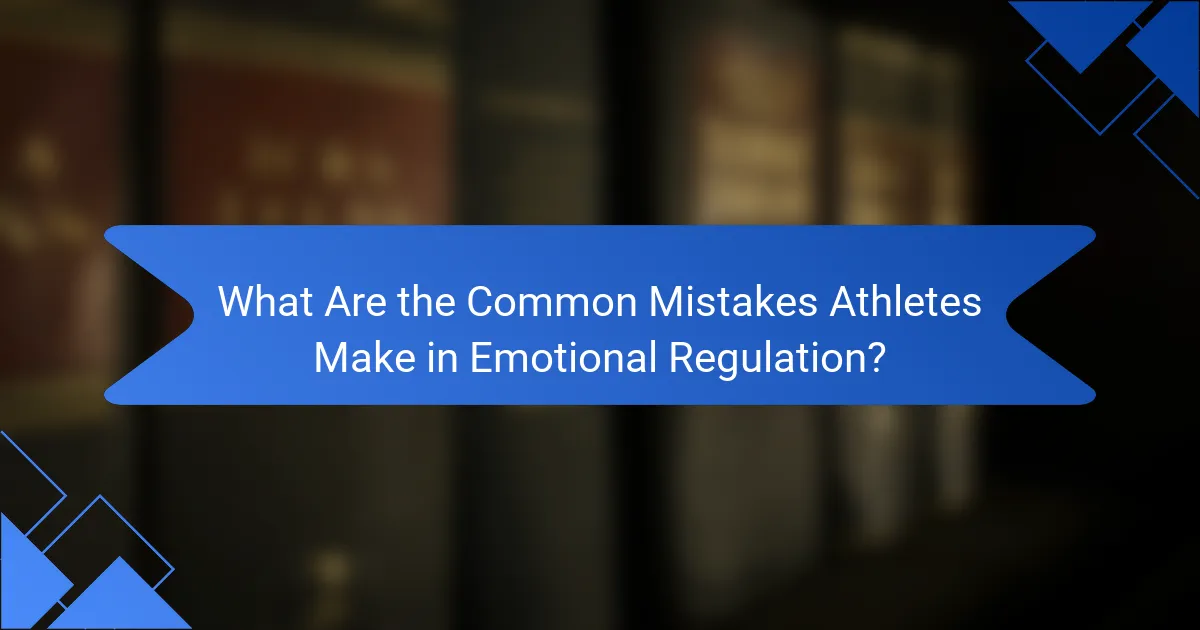
What Are the Common Mistakes Athletes Make in Emotional Regulation?
Athletes often struggle with emotional regulation, leading to performance issues. Common mistakes include ignoring emotions, failing to develop coping strategies, and not seeking support. These oversights can hinder peak performance and mental resilience. Recognizing and addressing these mistakes is crucial for athletes aiming to master emotional regulation.
How Can Athletes Avoid Overthinking During Competition?
Athletes can avoid overthinking during competition by focusing on the present moment and implementing mental strategies. Techniques such as visualization, mindfulness, and controlled breathing help maintain concentration. Practicing routines before events builds familiarity and reduces anxiety. Setting specific, achievable goals further directs focus and enhances performance.
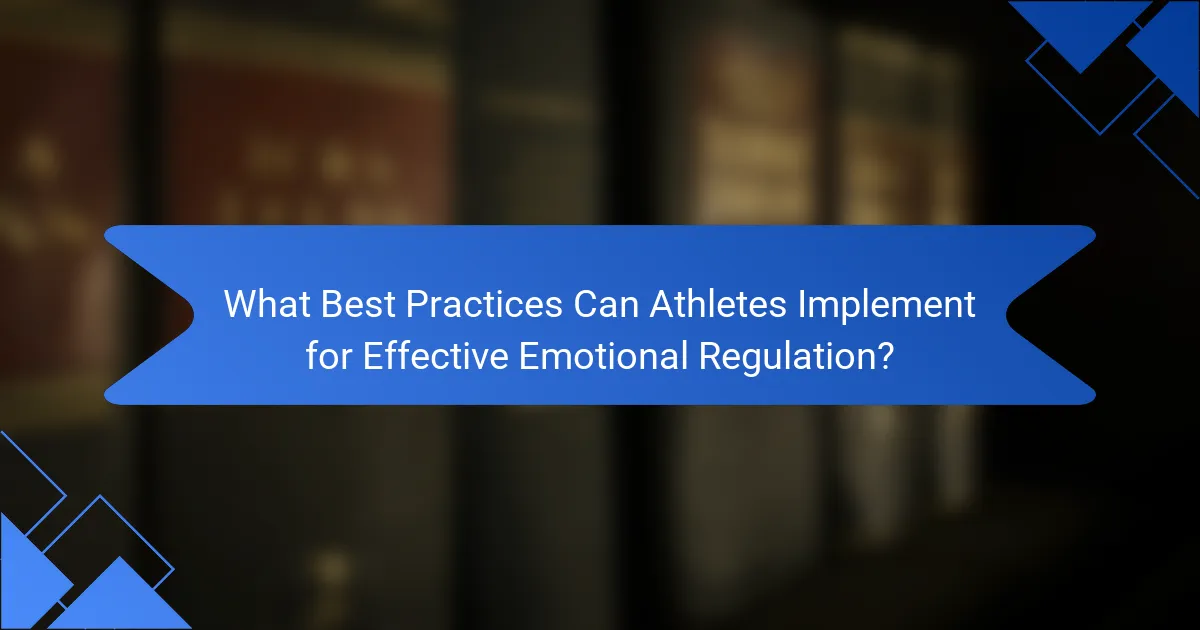
What Best Practices Can Athletes Implement for Effective Emotional Regulation?
Athletes can implement several best practices for effective emotional regulation, enhancing their performance. First, developing self-awareness through mindfulness techniques helps athletes recognize emotional triggers. Second, establishing a routine for emotional check-ins allows for consistent monitoring of feelings. Third, utilizing visualization techniques can prepare athletes for high-pressure situations. Fourth, engaging in regular physical activity promotes emotional stability. Lastly, seeking support from coaches or mental health professionals provides valuable guidance and strategies.
How to Create a Personal Emotional Regulation Plan?
To create a personal emotional regulation plan, identify your emotional triggers and responses. Establish specific strategies for managing these emotions, such as mindfulness techniques or breathing exercises. Regularly assess and adjust your plan based on performance outcomes. Track progress to enhance self-awareness and emotional control for peak sports performance.
What Steps Should Be Included in the Plan?
To effectively get to know yourself for mastering emotional regulation, follow these steps:
1. Self-Reflection: Dedicate time to introspection, identifying your emotions and triggers.
2. Set Goals: Define specific emotional regulation objectives to improve sports performance.
3. Practice Mindfulness: Engage in mindfulness techniques to enhance self-awareness during training and competition.
4. Seek Feedback: Gather insights from coaches and peers to understand your emotional responses and areas for improvement.
5. Monitor Progress: Regularly assess your emotional regulation skills and adjust your strategies as needed.
How to Monitor and Adjust the Plan Over Time?
To effectively monitor and adjust your emotional regulation plan, regularly assess your performance and emotional responses. Track progress through journaling or self-reflection, focusing on key metrics such as emotional stability and performance outcomes. Set specific intervals for review, such as weekly or monthly, to identify patterns and areas needing improvement. Adjust strategies based on these insights, ensuring they align with your evolving goals and experiences. This iterative process enhances your emotional mastery, ultimately optimizing peak sports performance.
What Resources Are Available for Further Learning on Emotional Regulation?
To enhance your understanding of emotional regulation, consider these resources. Books like “Emotional Intelligence” by Daniel Goleman provide foundational insights. Online courses on platforms such as Coursera and Udemy offer structured learning. Additionally, podcasts like “The Happiness Lab” explore practical applications. Joining workshops can also provide interactive experiences. Lastly, research articles in psychology journals keep you updated on the latest findings.
